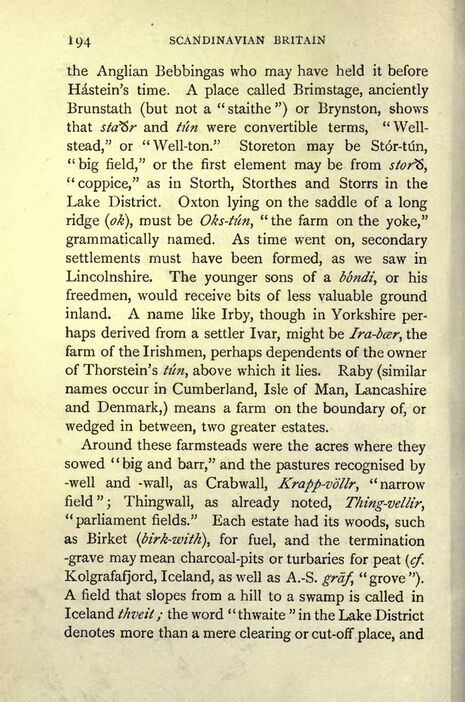
Full resolution (JPEG) - On this page / på denna sida - Scandinavian Britain - III. The Norse Settlements - 2. Cheshire and Lancashire

<< prev. page << föreg. sida << >> nästa sida >> next page >>
Below is the raw OCR text
from the above scanned image.
Do you see an error? Proofread the page now!
Här nedan syns maskintolkade texten från faksimilbilden ovan.
Ser du något fel? Korrekturläs sidan nu!
This page has been proofread at least once.
(diff)
(history)
Denna sida har korrekturlästs minst en gång.
(skillnad)
(historik)
the Anglian Bebbingas who may have held it before
Hástein’s time. A place called Brimstage, anciently
Brunstath (but not a "staithe") or Brynston, shows
that stadr and tún were convertible terms,
"Well-stead," or "Well-ton." Storeton may be Stór-tún,
"big field," or the first element may be from stord,
"coppice," as in Storth, Storthes and Storrs in the
Lake District. Oxton lying on the saddle of a long
ridge (ok) must be Oks-tún, "the farm on the yoke,"
grammatically named. As time went on, secondary
settlements must have been formed, as we saw in
Lincolnshire. The younger sons of a bóndi, or his
freedmen, would receive bits of less valuable ground
inland. A name like Irby, though in Yorkshire perhaps
derived from a settler Ivar, might be Ira-bær, the
farm of the Irishmen, perhaps dependents of the owner
of Thorstein’s tún, above which it lies. Raby (similar
names occur in Cumberland, Isle of Man, Lancashire
and Denmark,) means a farm on the boundary of, or
wedged in between, two greater estates.
Around these farmsteads were the acres where they
sowed "big and barr," and the pastures recognised by
-well and -wall, as Crabwall, Krapp-völlr, "narrow
field"; Thingwall, as already noted, Thing-vellir,
"parliament fields." Each estate had its woods, such
as Birket (birk-with) for fuel, and the termination
-grave may mean charcoal-pits or turbaries for peat (cf.
Kolgrafafjord, Iceland, as well as A.-S. gräf, "grove").
A field that slopes from a hill to a swamp is called in
Iceland thveit ; the word "thwaite" in the Lake District
denotes more than a mere clearing or cut-off place, and
<< prev. page << föreg. sida << >> nästa sida >> next page >>